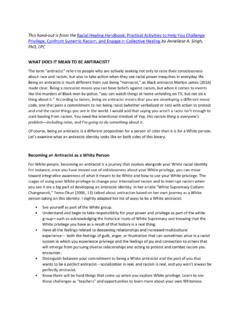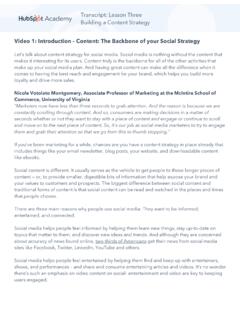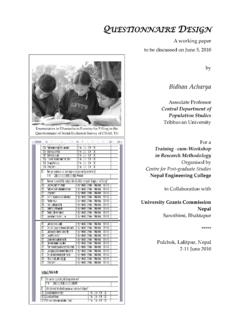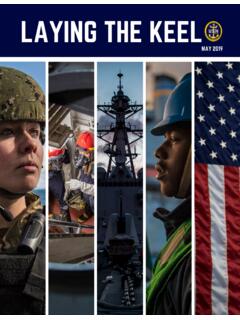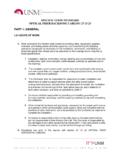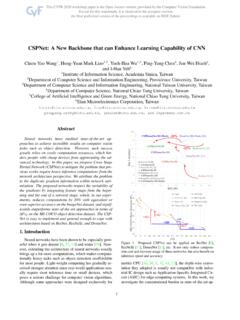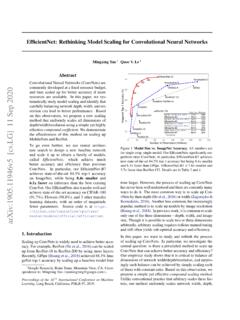Transcription of Black Women Civil Rights Movement - National Museum of ...
1 Women in the Modern Civil Rights MovementIntroductionWho comes to mind when considering the Modern Civil Rights Movement (MCRM) during 1954 - 1965? Is it one of the big three personalities: Martin Luther King Jr., Malcolm X, or Rosa Parks? Or perhaps it is John Lewis, Stokely Carmichael, James Baldwin, Thurgood Marshall, Ralph Abernathy, or Medgar Evers. What about the names of Septima Poinsette Clark, Ella Baker, Diane Nash, Daisy Bates, Fannie Lou Hamer, Ruby Bridges, or Claudette Colvin? What makes the two groups different? Why might the first group be more familiar than the latter? A brief look at one of the most visible events during the MCRM, the March on Washington, can help shed light on this question. On August 28, 1963, over 250,000 men, Women , and children of various classes, ethnicities, backgrounds, and religions beliefs journeyed to Washington to march for Civil Rights .
2 The goals of the March included a push for a comprehensive Civil Rights bill, ending segregation in public schools, protecting voting Rights , and protecting employment discrimination. The March produced one of the most iconic speeches of the MCRM, Martin Luther King Jr. s I Have a Dream" speech, and helped paved the way for the Civil Rights Act of 1964 and the Voting Rights Act of 1965. While the March advocated equality for African Americans in American society, the March was not progressive for gender equality and was dominated by men. The formal program initially excluded any prominent Women of the MCRM from speaking at the March. Anna Arnold Hedgeman, the sole woman on the Administrative Committee of the March, protested the lack of Women . In response, A. Philip Randolph, the March s organizer, and the male leadership, which included the Big Six (A.)
3 Philip Randolph, Martin Luther King, Jr., James Farmer, John Lewis, Roy Wilkins, and Whitney Young) decided to add Women in a short, rushed, Tribute to Negro Women Fighters for Freedom . Furthermore, Women were not included in the delegation that met with President Kennedy later that afternoon. The March on Washington highlights the sexism toward and marginalization of of Women within the MCRM. Research Questions to ConsiderWho were some of the Women leaders of the Modern Civil Rights Movement in your local town, city or state? What were the expected gender roles in 1950s - 1960s America? Did these roles vary in different racial and ethnic communities? How would these gender roles effect the MCRM? Who were the "Big Six" of the MCRM? What were their individual views toward Women in the Movement ? How were the ideas of gender similar or different with the MCRM and the later Black Power Movement ?
4 How did African American Women in the MCRM relate to Women in other Women of movements of the era (ex. Chicano, LGBT, or American Indian Movement )? Septima Poinsette Clark (1898 1987) Septima Poinsette Clark was an educator from South Carolina who developed the Citizenship Schools at the Highlander Folk School, and later through the SCLC (Southern Christian Leadership Conference). The Citizenship Schools taught and encouraged African Americans to learn and harness the power of literacy, education, and civics to gain their Civil Rights and empower their communities. Diane Nash (1938 ) While attending Fisk University in 1959, Diane Nash involved herself in the fledgling Civil Rights Movement in Nashville, Tennessee. By 1960, she was one of the most well-known and respected student leaders in the city. She was crucial in organizing the Nashville sit-ins.
5 She also helped sustain the Freedom Rides through the Deep South. Nash was a leader in SNCC (Student Nonviolent Coordinating Committee). Fannie Lou Hamer (1917 1977) Fannie Lou Hamer fought for Civil Rights in rural Mississippi, actively challenging the racist status quo by pushing for desegregation and African American voter registration. She was one the leaders of the 1964 Freedom Summer Campaign, which battled white supremacy, segregation, and racial violence in Mississippi. She also co-founded the Mississippi Freedom Democratic Party to integrate African Americans into the state's Democratic Height (1912 2010) Dorothy Height was known as the Godmother of the Civil Rights Movement because of her extensive involvement in the fight for Civil Rights since the 1930s. Early in her activist career, Height met Mary McLeod Bethune at a New York YMCA and became her prot g.
6 Height would come to help organize events during the MCRM, such as the 1963 March on Washington. She influenced leaders like Martin Luther King Jr. and John Lewis. She was a pioneer in the use of political organization, and strongly advocated for Women s Rights in the United States and Baker (1903 1886) In April 1960, Ella Baker was essential in organizing the founding conference of the SNCC (Student Nonviolent Coordinating Committee) at Shaw University in Raleigh, North Carolina. She persuaded Martin Luther King Jr. toinvest in the conference. SNCC would help to cultivate the energies of young people around the nation ready and willing to involve themselves in the MCRM. (Some) Women of the Movement : Women were the backbone of the MCRM from small towns to the National Movement . Women played a crucial role asstrategists and advocates.
7 They participated despite the dangers including violence, homelessness, unemployment,sexual assault, and death. Exploring the MCRM beyond its familiar narrative will highlight the conflicts, compromises,and complexities that allows for a greater understanding of the MCRM. This exploration will rightly acknowledge thecontribution of the many Women whose blood, sweat, tears, and dedication helped gain Civil Davis (1944 ) In 1963, Angela Davis joined the MCRM after the bombing of Sixteenth Street Baptist Church that killed four young girls. Davis would be better-known for her participation in the Black Power Movement , Black Panther Party, and the American Communist Party in California. McCree Harris (1934 2000) McCree Harris was part of the Civil Rights Movement in Albany, Georgia. As an educator at Monroe Comprehensive High School, she urged young people to get involved in the MCRM.
8 She was also part of the Freedom Singers. The Freedom Singers used music fundraise for SNCC (Student Nonviolent CoordinatingCommittee) and educate about events during the Sherrod (1948 ) Shirley Sherrod became active in the MCRM after her father was shot to death by a white farmer in 1965. She was an organizer for the SNCC Southwest Georgia Project along with her husband, Charles Sherrod. Through the Southwest Georgia Project, she strongly advocated for African American land ownership and land Carr (1911 2008) Johnnie Carr was politically active in Montgomery, Alabama. In 1931, she raised money for the nine young African American men wrongly accused in the Scottsboro Trials. Later, through her NAACP chapter, she became involved with the Montgomery Bus Boycotts. Carr was instrumental in working "behind-the-scenes" to organize the 13- month boycott.
9 In 1964, she and her husband filed a suit against the Montgomery County Board of Education for their son to attend the all-white Sidney Lanier High School. They won their case in Glass (1916 2012) Thelma Glass was a geography professor at Alabama State University, and part of the Women s Political Council in Montgomery, Alabama. The council was critical in organizing the Montgomery Bus Boycott. Georgia Gilmore (1920 1990) Georgia Gilmore used her talents in cooking and as a restaurateur to help support the Movement in Montgomery, Alabama. She participated in the Montgomery Bus Boycott, and was fired from her job because of her participation. She opened a restaurant in her home, which became a safe space for local Civil Rights leaders. Also, she formed the Club From Nowhere, which consisted of African American Women cooking and selling cakes and pies to Black and white customers.
10 The money went to support efforts in the bus Bates (1914 1999) Daisy Bates was active in the Civil Rights Movement in Arkansas. She and her husband published a weekly paper that advocated for African American Civil Rights , The Arkansas Press. She was instrumental in desegregating schools in the state immediately after the Brown v. Board of Education (1954) decision. She mentored, supported and organzied the nine students, also known as the Little Rock Nine , selected to integrate Little Rock Central High School in Scott King (1927 2006) Influenced by her parents, Coretta Scott King pursued a musical education at Antioch College in Yellow Springs, Ohio. She encountered discrimination and segregation during her studies, which prompted her to join the local NAACP chapter. In 1953, she married Martin Luther King Jr.
